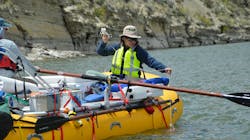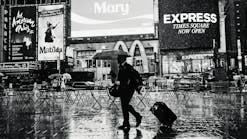In 1968, at the height of the Cold War, an attack class nuclear submarine, the U.S.S. Scorpion was lost at sea. The submarine went missing just five days before it would have arrived at the dock in Newport News, Va.
For nine days, the Navy searched with no success. Coordinating with the ongoing search, Navy scientist John Craven assembled a diverse team of civilian experts to track down the submarine. Although the term itself wasn’t widely used at the time, he enacted a form of “crowdsourcing” — a practice that could be immensely valuable for stormwater outreach.
By definition, crowdsourcing is a process of organizing and coordinating the labor, knowledge, and intuition of a crowd. Crowdsourcing can serve for anything from simply collecting large amounts of data for later analysis, to solving an incredibly difficult problem — like finding a submarine presumed to be lost in the middle of a vast ocean.
Using crowdsourcing very much in the form of a contest, each member of Craven’s chosen crowd was instructed to work independently, each assessing the Scorpion’s fate without the influence of other crowd members. Each worked, initially, from the Navy’s existing database of information; however, they were free to draw upon other theoretical, scientific, and mathematical information if they believed those resources might be useful.
On a preset deadline, using a probability methodology called Bayes Theorem, Craven’s entrants came up with one collaborative estimate of its location — essentially, the statistically most-likely resting place of the ill-fated Scorpion.
Five months later, the Navy finally located the Scorpion lying on the ocean floor. Although no one individual among Craven’s theoreticians came up with the precise location of that submarine, the team’s collective average pinpointed a location that was a mere 220 yards off from where the missing submarine was ultimately found.
How Craven’s group of people, working independently under a naval scientist’s guidance, could have collectively been so accurate is a phenomenon that still amazes many.
Yet, the fact remains that a group average, even when it is derived from something as simple as broad, crowdsourced data collection, tends to be relatively accurate in ways that may be of enormous positive impact to various communities. Enter crowdsourcing and what it can mean to stormwater public outreach and education.
Programs, Permits & Compliance Webinar
Learn more about crowdsourcing in the author's Stormwater University course by the same name. In this on-demand webinar, attendees will learn how simple data gathering, like CrowdHydrology, can help educate the public and gain important data with a minimal investment. Earn 0.1 CEU/1 PDH. Register here.
Crowdsourcing Stormwater Outreach and Education
For over a century, the U.S. Geological Survey (USGS) has actively encouraged Americans to get involved in local projects designed to map the entire country.
While the USGS produced the US topographic map through its own expertise, it has also benefited from crowdsourcing to improve and refine the accuracy of that map. Today, there are thousands of volunteers participating in the USGS’ mapping challenge by submitting data points collected from all areas of the country.
Today, crowdsourcing continues to be enticing as a cost-efficient way to not just gather important flood potential data but also to engage and educate the public about stormwater issues and concerns. For example, it potentially engages and educates the very non-point pollution sources that are the hardest to regulate — the ones generated by the general public itself.
Collecting data that can reveal stormwater runoff changes is a relatively new type of crowdsourcing gaining momentum. One example that began in 2010, CrowdHydrology, allows citizen scientists to use smartphone technology to text data regarding stream levels at various gauging stations placed along rivers and aquifers, which is then collected and analyzed.
The idea of enlisting citizen scientists to collect stream level readings in their communities was the brainchild of Dr. Christopher Lowry, a professor of hydrogeology at the University of Buffalo, and Dr. Michael Fienen, a research hydrologist at the U.S. Geological Survey Wisconsin Water Science Center.
Participation in the program is simple, with a relatively low cost to non-profit organizations. The only cost of entry is limited to the cost of each meter and its signage, which is typically less than $100 each. All the data collection and resulting analysis for the program is free.
Once the gauge and sign have been properly installed, anyone with a smartphone can text the stream level to the number on the sign. According to Lowry, the group averages obtained against all of the texted stream level reports are often found to be surprisingly accurate. Generally, it is best for the gauge to be located on a busy trail along a stream with good visibility and where the water levels are most likely to fluctuate due to precipitation and water runoff.
Another example of successful data crowdsourcing can be found with the Community Collaborative Rain, Hail, and Snow Network (CoCoRaHS). This program encourages its participants to take measurements of the amount of precipitation after each time a rain, hail, or snowfall crosses through their community.
Here again, the program is both voluntary and free; however, each citizen must purchase their own high-capacity 4-inch-diameter rain gauge. Then, the volunteer-reported precipitation data is used by the National Weather Service and other agencies. The data collected is shown on CoCoRaHS’ website, where it has been organized and presented to apply to daily situations ranging from vital water resource analysis and severe storm warnings to something as simple as neighbors comparing how much rain fell in their respective backyards.
Equally important to data collection is the ongoing success in using crowdsourcing for stormwater education and public outreach, which is revealed by the positive comments and reviews that the participants have left on the website.
Stormwater entities are also using crowdsourcing to gain funding, hold contests, and even change public perceptions and behaviors by getting people to take the pledge to protect waterways.
Yet, like anything else, there are instances in which crowdsourcing can be misused. In such cases, crowdsourcing can backfire, quickly revealing why certain things should never rely on crowd participation. And while no rules are ever absolute, there are some guidelines to consider to avoid crowdsourcing disasters.
How to Avoid Crowdsourcing Disasters
What makes crowdsourcing such a powerful tool for engaging the public is also what can make it so dangerous — loss of control. There is no quality control over each and every participant.
When using crowdsourcing, the control offered to the public should never involve anything that could be harmful. That’s why it is important that public engagement does not affect anything essential to the organization such as its mission, vision, or brand.
For example, when NASA decided to promote a popular vote to name a new section of the International Space Station, they made sure to start with a few of their own suggestions. Unfortunately, they also decided to include a write-in option.
By the end of the voting process, a comedian’s fans gave his name six times more votes than any of the pre-approved name suggestions. NASA was obliged to reject the winning name. Had NASA not offered up a “write-in” name, the public relations disaster might have been avoided.
A group asking for public input can never know what response they might get. The following six crowdsourcing guidelines can avoid such disasters.
- Not Critical. It’s important that crowdsourcing requests are not critical to the organization’s mission.
- Definable Task. It is essential to make the task easily definable when requiring either answers to difficult questions or information. Several stormwater organizations have realized success with easy-to-understand requests to gain funding, collect data, and education. For example, the Washington State Department of Ecology is engaging its residents by asking them to take the “Protect Our Waters Pledge,” providing residents with ten things they can do to make a difference in protecting the waterways.
- Minimum Skills. When engaging the general public, it is best to ask for tasks which require minimum skills. For a stormwater organization, this means simple tasks, like collecting water level or precipitation data, would be better than anything technical.
- Visible Outputs/Results. By making the outputs visible, participants tend to feel valued and more engaged. It also works as a way to gain more volunteers or to generate more funding. For example, when going for funding, organizations should show the monetary goals and their progress in achieving them. When collecting data, the results should be easy to access and understand. Successful campaigns, like CrowdHydrology, organize and post all their crowdsourced data on their websites for easy review.
- Recognition. It is important to recognize individuals, even publicly when appropriate, for anything from their funding support to their volunteer efforts. Recognizing people publicly for their involvement, no matter how small the time or monetary investment, continues to be something that stormwater organizations attribute to the ongoing success of their crowdsourcing programs.
- Launch Failure. Even a perfectly-planned crowdsourced campaign cannot become a success if nobody participates. While the initial launch can start with a social media campaign and a website, sometimes a successful outcome starts with a few key individuals. When designing a program using crowdsourcing for public outreach, organizations should consider how to get the word out initially — especially if it’s a first effort. Successful campaigns may require inviting specific, high-profile people to start the engagement. This list can be made up of stakeholders, elected officials, community leaders, influencers, or school administrators. The idea is that, in order to attract a crowd, it’s best to start with prominent individuals in the community. While a strategic selection of influential people can get your efforts off the ground, it will take continued effort and dedication to keep a movement’s momentum.
The Takeaway
When it comes to solving large-scale problems like finding the U.S.S. Scorpion or collecting data to protect waterways, crowdsourcing has been proven to provide accuracy, cost-efficiency, and public engagement and education. Today, stormwater organizations continue to use crowdsourcing very successfully in a wide array of applications, all while engaging and educating the public.
When implemented correctly, crowdsourcing can offer up much-needed data collection, answers to difficult questions, funding, and, equally important, the ability to engage all the non-point pollution sources that are not always easy to identify and regulate.
Crowdsourcing can educate people, indirectly or directly, about how simple things — like not littering, not using stormwater drains as trashcans, limiting the use of pesticides and herbicides, or picking up after their dogs — can make a huge difference in protecting waterways. Each person’s volunteer efforts, whether large or small, can make a difference. SW
Sources1. James Surowiecki, The Wisdom of the Crowds, New York, Random House, 2004.2. Ed Offley. "The U.S.S. Scorpion Buried at Sea," HistoryNet, August 26, 2009, www.historynet.com/the-uss-scorpion-buried-at-sea.htm3. "USGS Step Up to the Challenge crowdsourcing program," April 7, 2020, accessed November 2021, www.usgs.gov/news/step-challenge.4. C.S. Lowry and M.N. Fienen, CrowdHydrology: crowdsourcing hydrologic data and engaging citizen scientists, Ground Water, (2013) 51(1):151-156, doi:10.1111/j.1745-6584.2012.00956.
Melanie Goetz is a stormwater public outreach consultant, author, and speaker. She is President of Hughes & Stuart, a full-service marketing firm that specializes in communicating the value of water and energy.
Published in Stormwater magazine, February 2022.







